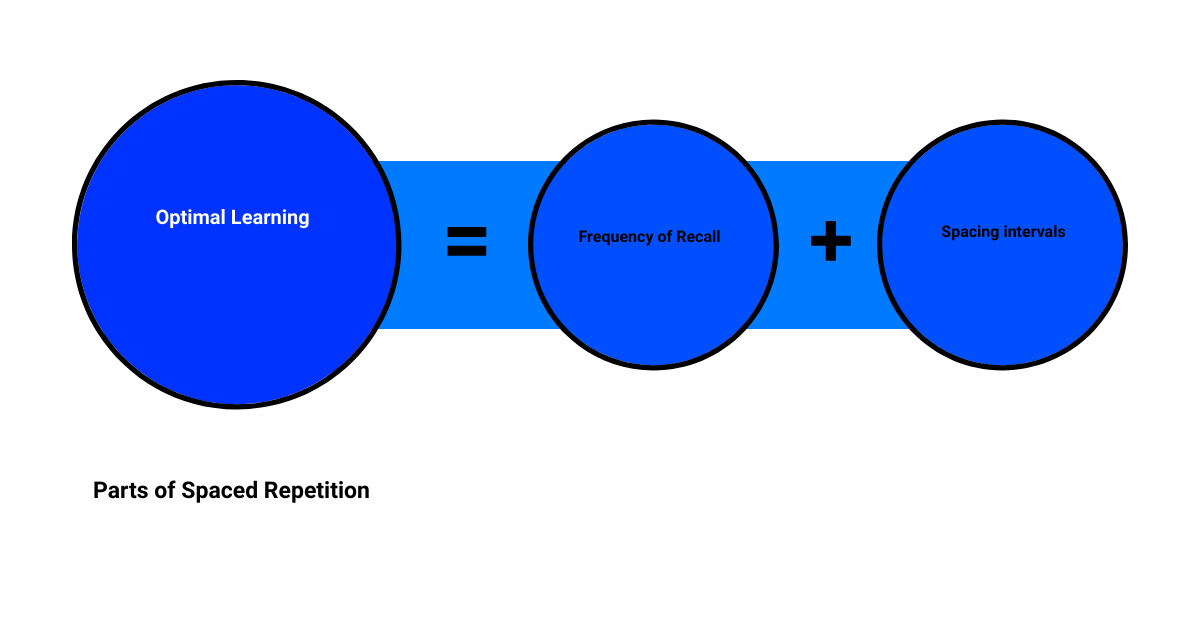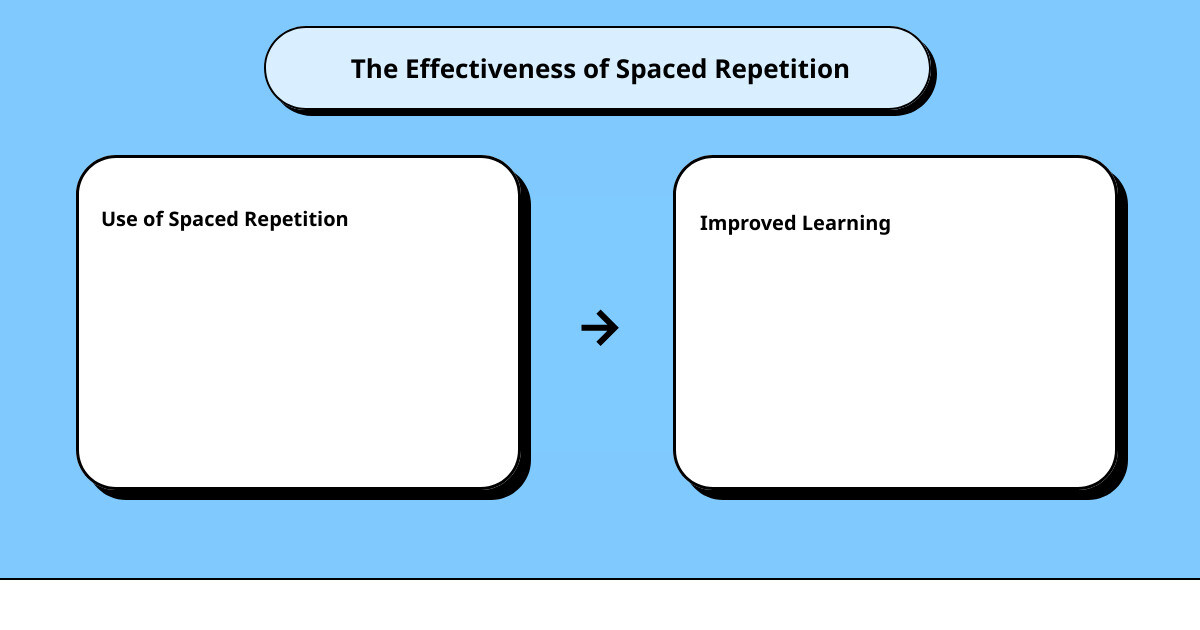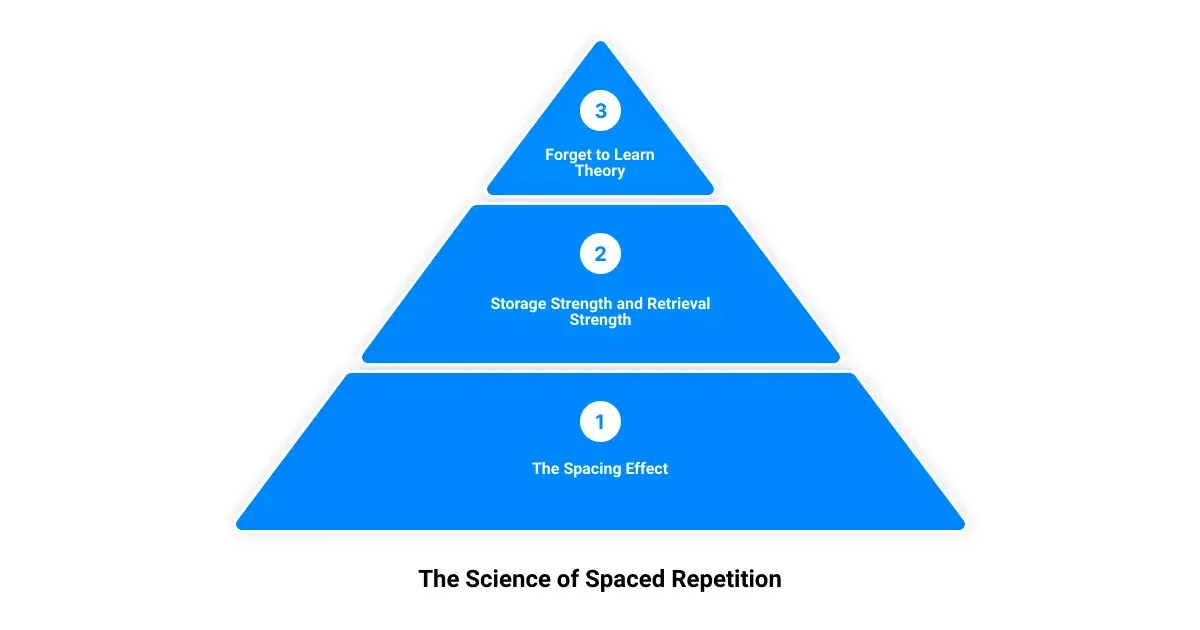Imagine if you could unlock a learning technique that dramatically improves your memory retention, especially when you're learning something as complex as Mandarin Chinese. Welcome to the world of Constant Spaced Repetition.
Constant Spaced Repetition is a scientifically backed method that enhances learning effectiveness by leveraging the spacing effect, a cognitive science principle that exploits our brain's natural learning rhythms. It involves revisiting and reviewing information at increasing intervals over time, ensuring the knowledge is deeply etched into your long-term memory.
Whether you're a language learner grappling with Chinese characters or a professional striving to keep abreast of the latest in your field, understanding and applying Constant Spaced Repetition can revolutionize your learning process. By the end of this guide, you'll have a comprehensive understanding of how this technique works and how to incorporate it into your learning routine, helping you achieve your learning goals faster and more efficiently.
In the upcoming sections, we'll delve into the cognitive science behind Spaced Repetition, explore its mechanics, and reveal practical tools and strategies for implementing it, including the innovative learning app, Traverse. We'll also highlight the evidence-based benefits of Spaced Repetition and its effectiveness in real-life scenarios, such as test preparation and second-language learning.
Let's embark on this exciting journey to unlock your learning potential and master knowledge retention with Constant Spaced Repetition.
Understanding the Science Behind Spaced Repetition
Peel back the layers of constant spaced repetition, and you'll discover a fascinating interplay of cognitive science principles. These principles work together, not just to help us cram for an exam, but to truly embed knowledge in our long-term memory. Let's take a closer look.
The Spacing Effect and Its Impact on Learning
Imagine you're building a brick wall. If you stack the bricks too quickly without letting the mortar dry, your wall will likely crumble. Learning operates on a similar principle, known as the spacing effect. Our brains learn more efficiently when we spread out our study sessions over time, allowing our mental 'mortar' to dry and solidify the knowledge. Just like in wall-building, rushing the process often leads to ineffective results.
Robert Bjork, a renowned psychologist, coined the term desirable difficulty to explain this phenomenon. He proposed that learning is most effective when it poses a challenge, but not so hard that it becomes overwhelming. Spaced repetition, with its increasing intervals of review, provides just the right amount of challenge to keep us engaged and optimize our learning.
Storage Strength and Retrieval Strength: The Two Strengths of Memory
Understanding how our memory works is crucial in leveraging the benefits of spaced repetition. Cognitive science suggests that memories have two strengths: storage strength and retrieval strength.
Storage strength pertains to how well the information is embedded in our memory. It doesn't fade over time and can only be increased through repeated recall or use. On the flip side, retrieval strength refers to how easily we can access that memory. This aspect is more fragile and fades over time unless maintained through regular recall.
Interestingly, forgetting is not primarily an issue of lost storage strength, but rather a problem of declining retrieval strength. Think of your brain as a vast library. The information (books) is still there, but without regular maintenance, we struggle to locate it. This is where spaced repetition comes in, serving as the 'librarian' that keeps our mental catalogue organized and easily accessible.
The "Forget to Learn" Theory: The Role of Forgetting in Learning
Counterintuitively, forgetting plays a crucial role in learning. Benedict Carey, in his book "How We Learn", discusses the "Forget to Learn" theory. The theory suggests that a certain degree of forgetting must occur for us to strengthen learning when we revisit the material. Without a bit of forgetting, you gain no benefit from further study. It's this process that allows learning to build, much like an exercised muscle.
The "Forget to Learn" theory is the secret sauce in the effectiveness of spaced repetition. It allows us to maximize desirable difficulty, which in turn, maximizes our learning. So, if you've ever felt frustrated about forgetting something, remember—it's just your brain creating room for stronger learning.
Grasping these concepts of the spacing effect, the dual strengths of memory, and the role of forgetting in learning, can help us understand why spaced repetition is such a potent tool in our learning arsenal. Armed with this knowledge, you can transform the way you learn and remember, whether it's mastering Mandarin characters or any other subject of interest.

The Mechanics of Constant Spaced Repetition
Unleashing the power of constant spaced repetition in your learning journey requires a clear understanding of its mechanics. This learning strategy is not just about studying the same lessons at increasing intervals; it's about the frequency and quality of recall, the strategic use of spacing intervals, and the optimal repetition schedule.
The Importance of Frequency and Quality of Recall
At the heart of constant spaced repetition is the act of recalling the information you want to remember over time. This process is known as active recall. In contrast to passive review, active recall requires you to retrieve knowledge from memory, which effectively strengthens your retrieval paths and solidifies the information in your long-term memory. This technique has been proven to be significantly more effective than merely re-reading or reviewing material.
However, it's not just about the frequency of recall; the quality of recall also matters. When you recall information correctly, it advances in the repetition cycle, moving to less frequent review intervals. But if you recall it incorrectly, it returns to the initial stage for more aggressive review and repetition. This way, you focus more on challenging material while reinforcing what you've already mastered at spaced intervals.
The Role of Spacing Intervals in Spaced Repetition
The concept of spacing intervals is central to the mechanics of constant spaced repetition. The idea is to strategically space your study sessions to maximize retention and minimize the time spent re-learning. This is based on the spacing effect, a cognitive phenomenon where learning is greater when studying is spread out over time as opposed to studying the same amount of content in a single session.
These intervals are not chosen randomly. They are determined based on evidence-based learning techniques, often implemented through an algorithm or a schedule. The key is to find the right balance between too soon (which makes the recall too easy) and too late (where you've forgotten the information and have to re-learn it).
Optimal Spaced Repetition Time Intervals: 1 Day, 7 Days, 16 Days, and 35 Days
When it comes to determining the optimal intervals for spaced repetition, research conducted by Dr. Piotr Wozniak, the developer of the first computer algorithm for spaced repetition, suggests a schedule of 1 day, 7 days, 16 days, and 35 days after the initial learning session. This schedule is designed to engage your brain with the information in a way that promotes long-term memorization.
However, remember that the best spaced repetition schedule is the one you can stick to. You may need to tweak these intervals to fit your personal learning style and the demands of the material you're studying. The key to success with constant spaced repetition is consistency, and the beauty of this method is that it can be adapted to meet your individual needs.
In the next section, we'll explore different methods and tools to implement constant spaced repetition, including the Leitner System and various learning apps. Stay tuned to learn how to supercharge your memory retention and accelerate your learning.

Implementing Constant Spaced Repetition: Methods and Tools
Whether you're a seasoned learner or just starting to explore the realm of memory techniques, using the right methods and tools can significantly enhance your learning efficiency. In this section, we will delve into some practical ways to implement constant spaced repetition, including the Leitner System and various learning apps like Anki and Traverse.
The Leitner System: A Simple Way to Implement Spaced Repetition
The Leitner System, named after German scientist Sebastian Leitner, is a simple yet effective method of implementing spaced repetition. It revolves around the use of flashcards, where each card contains a question or concept on one side and the answer or explanation on the other. The flashcards are sorted into different boxes, each representing a specific review interval.
As you study, correctly recalled cards progress to a box with a longer review interval, while those you struggle with return to the first box for more frequent review. Over time, this system ensures that you're reviewing the right information at the right time, making your study sessions incredibly efficient.
Using Spaced Repetition Apps: Anki and Its Alternatives
While the Leitner System is an excellent method, the digital age brings us advanced tools like Anki that make spaced repetition more accessible and efficient. Anki is a popular choice among learners for its flexibility and extensive library of shared decks. These digital flashcards are based on the same principle as the Leitner System, but with the added advantage of portable, customizable, and easily accessible learning.
Traverse: A Learning App Combining Mind Mapping, Spaced Repetition Flashcards, and Connected Note-Taking
For a more integrated learning experience, especially for our lifelong learners focused on mastering Mandarin, Traverse takes spaced repetition to a whole new level. This app combines mind mapping, spaced repetition flashcards, and connected note-taking into one powerful tool.
One standout feature of Traverse is the ability to import Anki decks. This means you can bring your existing flashcards into Traverse and continue your learning journey there. It also allows you to create flashcards directly from your notes and view your flashcards within your knowledge tree, providing a broader context for your learning.
In addition, Traverse collaborates with Mandarin Blueprint to provide a comprehensive and integrated approach to learning Mandarin. By combining the language learning expertise of Mandarin Blueprint with the advanced spaced repetition capabilities of Traverse, you can make your Mandarin learning journey more enjoyable and productive.
Implementing constant spaced repetition is not just about memorizing facts, but about integrating your learning into a broader context. With the right methods and tools, you can unlock the full potential of spaced repetition, optimizing your learning efficiency, and maximizing your knowledge retention.

The Effectiveness of Constant Spaced Repetition
Imagine having a secret weapon that significantly boosts your learning efficiency. Welcome to the world of constant spaced repetition, a method that is not just about making learning easier - it's about making it smarter, more efficient, and more effective. Its efficacy is backed by robust scientific evidence and its benefits span a wide spectrum of learners.
Evidence-Based Benefits of Spaced Repetition
In the realm of learning strategies, spaced repetition shines like a beacon. A meta-analysis of 29 studies confirmed that the spacing effect is well-established, with spaced practice being 74% more effective compared to massed practice, or cramming. This demonstrates the power of spaced repetition as a method that significantly boosts learning efficiency.
Moreover, it has been proven beneficial when it comes to long-term memory. By increasing the time spent actively rehearsing a memory in your brain, rather than passively consuming information, and allowing for consolidation of new information with old related knowledge that's already stored in long-term memory, spaced repetition makes it easier to retrieve and recall the information at later dates.
Spaced Repetition in Vocabulary Acquisition and Second-Language Learning
For language learners, and especially for those grappling with the complexities of Mandarin, the benefits of spaced repetition are particularly valuable. By strategically spacing out study sessions, this method allows you to optimize your memory retention and efficiently learn new material.
This technique is especially effective in vocabulary acquisition - a crucial aspect of language learning. It allows learners to continually re-expose themselves to new words and phrases at spaced intervals, reinforcing their memory and aiding recall.
The Impact of Spaced Repetition on Individuals with Memory Impairments
The power of spaced repetition extends beyond the typical learner. Remarkably, it can also be beneficial for individuals with memory impairments. This method helps in building memories that have high storage strength, making it a highly effective strategy for individuals facing memory challenges.
In conclusion, the constant spaced repetition is not just a memory-enhancing tool, but a comprehensive learning strategy with a wide range of applications. Whether you're learning Mandarin or tackling a different subject, incorporating this method into your study routine could be the game-changer you need to optimize your learning journey.

Applying Constant Spaced Repetition in Real-Life Scenarios
If you've ever wondered how to turn the power of constant spaced repetition into practical applications, you've come to the right place. In this section, we will explore how this technique can be harnessed for test preparation and learning Mandarin Chinese with the help of Traverse.
Using Spaced Repetition for Test Preparation
Regardless of whether you're studying for a life-changing exam like the SAT or GRE, or simply aiming to ace your next quiz, constant spaced repetition can make a world of difference. By reviewing information at strategic intervals, you're reinforcing the material in your memory, making it easier to recall when the test day comes.
Instead of cramming the night before an exam, which is akin to trying to run a marathon without prior training, spaced repetition encourages gradual learning. This approach not only results in better long-term memory recall compared to rote learning and cramming, but also reduces the overall amount of time spent on study sessions. With its focus on frequency and quality of recall, spaced repetition ensures that the knowledge you acquire is deeply ingrained in your memory, making it accessible when you need it the most – during your exam.
Learning Mandarin Chinese with Spaced Repetition and Traverse
When it comes to learning Mandarin Chinese, a language known for its thousands of unique characters, constant spaced repetition can be a powerful ally. By reviewing characters at increasing intervals, you reinforce their pronunciation, tone, and meaning in your memory.
Traverse, in partnership with Mandarin Blueprint, offers a comprehensive learning experience that combines the power of spaced repetition with immersive course content. Traverse’s AI-driven algorithms adapt to your performance, scheduling reviews at the optimal time to aid retention. This means you'll review challenging characters more frequently, while easier ones will be revisited less often.
Additionally, Traverse allows you to import your Anki decks, preserving your scheduling information and ensuring a seamless learning experience. This combination of comprehensive curriculum and personalized review schedule makes Mandarin learning not just efficient, but also enjoyable and rewarding.
In essence, by applying constant spaced repetition in real-life scenarios such as test preparation and Mandarin learning, you can unlock your learning potential and master knowledge retention. The key is to remain consistent, patient, and keep in mind that the goal is long-term knowledge retention, not short-term cramming. With such a mindset and the right tools like Traverse, mastering any subject becomes a much smoother and rewarding journey.
Conclusion: Unlocking Your Learning Potential with Constant Spaced Repetition
Mastering Mandarin, or any other subject, is no small feat. However, with the power of constant spaced repetition, this mountainous endeavor can transform into a series of achievable, well-spaced steps. The science-backed technique of spaced repetition isn't just another flash in the pan learning fad; it's a proven strategy rooted in the understanding of our brain's memory processes.
Implementing constant spaced repetition in your learning routine can substantially improve your long-term memory recall, making it an ideal strategy for lifelong learners. The technique's success lies in the optimal spacing intervals, which strategically allow for a degree of forgetting to take place. This 'forget to learn' approach may seem counterintuitive, but it makes retrieval effortful, thereby strengthening your memory.
While it's one thing to know the theory behind spaced repetition, applying it effectively is another. The Leitner System and spaced repetition apps like Anki remove the guesswork and provide a structured approach to implementing this method. But for a truly holistic learning experience, you can leverage the power of Traverse. This innovative learning app goes beyond traditional flashcards, combining mind mapping and connected note-taking with spaced repetition to enhance your learning journey.
When it comes to the effectiveness of constant spaced repetition, the evidence speaks for itself. From vocabulary acquisition to second-language learning, and even assisting individuals with memory impairments, spaced repetition has shown its versatility and efficacy. It's particularly beneficial for those preparing for tests or learning complex subjects like Mandarin Chinese.
Remember, the journey of mastering knowledge retention with constant spaced repetition is not a sprint; it's a marathon. It requires patience, consistency, and an understanding that learning is a process. But as the adage goes, 'Rome wasn't built in a day.' With constant spaced repetition as a cornerstone of your learning strategy, you'll be steadily building your 'Rome' - one optimally spaced learning session at a time.
In conclusion, constant spaced repetition is less of a secret weapon and more of an open secret in the world of effective learning. It's a tool available to anyone willing to implement it, and the rewards it offers are profound. So why wait? Start unlocking your learning potential with constant spaced repetition today. After all, every day is a new opportunity to learn something new!

